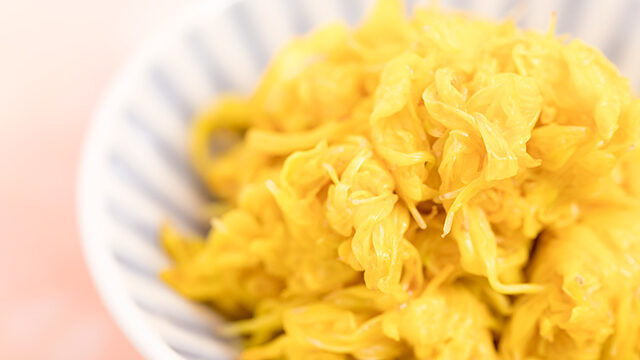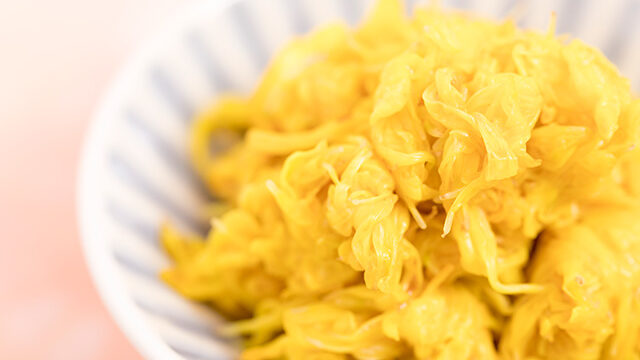
Hey there! Did you know that in Yamagata Prefecture, they don’t just admire chrysanthemums; they eat ’em! With a thriving production of edible chrysanthemums (excluding those tiny ones for sashimi garnish), you’ll find various local dishes featuring these colorful blooms. Eating chrysanthemum petals became popular way back in the Edo period, and even the famous poet Matsuo Basho was said to be a fan. Today, Yamagata folks still enjoy this tradition, and “Edible Chrysanthemum Ohitashi” is a prime example.
Dish Name: Edible Chrysanthemum Ohitashi
- Region / Location: Yamagata Prefecture
- Primary Area of Tradition: Throughout the prefecture
- Main Ingredients: Edible chrysanthemums, vinegar, soy sauce
How It’s Eaten / Served
Only the petals are eaten. The chrysanthemums are washed, the petals are separated from the base, and then they’re briefly boiled in water with a splash of vinegar. This helps to bring out the beautiful color, especially in the “Mottenohoka” variety, which contains anthocyanin. After boiling, the petals are drained, rinsed in cold water, and then seasoned with soy sauce or dashi-flavored soy sauce. Many locals love the unique crunchy texture and slightly bitter taste. You’ll also see it mixed with spinach or combined with seasoned nameko mushrooms and mountain vegetables in a grated daikon radish dressing. Walnuts are a great flavor pairing, often used as a topping or even mixed in for a richer “walnut ae” (dressed with walnuts).
Cultural Background and Preservation
Yamagata Prefecture has a strong culture of eating edible chrysanthemums, with the practice becoming widespread after the Edo period. The “Mottenohoka” variety, a late-blooming purple chrysanthemum, is particularly prized for its fragrance and flavor. Its name, meaning something like “outrageous” or “unthinkable,” supposedly comes from the idea of eating the imperial crest (though that’s just one theory) or simply because it’s “outrageously delicious.” Its distinct crisp texture comes from its tubular petals rather than flat ones. While the peak season is autumn to early winter, various cultivated varieties now extend the harvest from May to January. Around September 9th, the Chrysanthemum Festival (Choyo no Sekku), yellow “Kotobuki” chrysanthemums are common. You’ll often see edible chrysanthemums grown in home gardens throughout the prefecture, not just by farmers. Supermarkets and local produce stands sell bags and boxes of just the petals right alongside other vegetables, and some areas even include them in school lunches.
Additional information:
- Edible chrysanthemum (shokuyo giku): Chrysanthemum flowers that are grown specifically for consumption.
- Ohitashi: A Japanese dish where blanched vegetables are dressed with soy sauce, often with dashi.
- Mottenohoka (延命楽 – Enmeiraku): A specific late-blooming purple variety of edible chrysanthemum highly regarded in Yamagata.
- Anthocyanin: A type of pigment that gives fruits and flowers a red, purple, or blue color.
- Nameko: Small, amber-colored mushrooms with a slightly slimy texture, commonly used in Japanese cuisine.
- Dashi: A Japanese soup stock made from ingredients like dried bonito flakes, kelp, dried sardines, or shiitake mushrooms.
- Choyo no Sekku (重陽の節句): Also known as the Chrysanthemum Festival, celebrated on the ninth day of the ninth month.
The information about regional cuisine featured on this website (Piggy's Grandma of Japan) is summarized and adapted from the Ministry of Agriculture, Forestry and Fisheries of Japan (MAFF) website, "Our Regional Cuisines"Additional commentary is provided based on the unique experiences and perspectives of the site's editors.
The copyright for the original content regarding regional cuisine belongs to the Ministry of Agriculture, Forestry and Fisheries of Japan.
The summaries and adaptations published on this site are intended for informational purposes only. Piggy's Grandma of Japan does not guarantee the accuracy or completeness of this information. For the most accurate and complete details, please refer to the original pages on the MAFF website.


